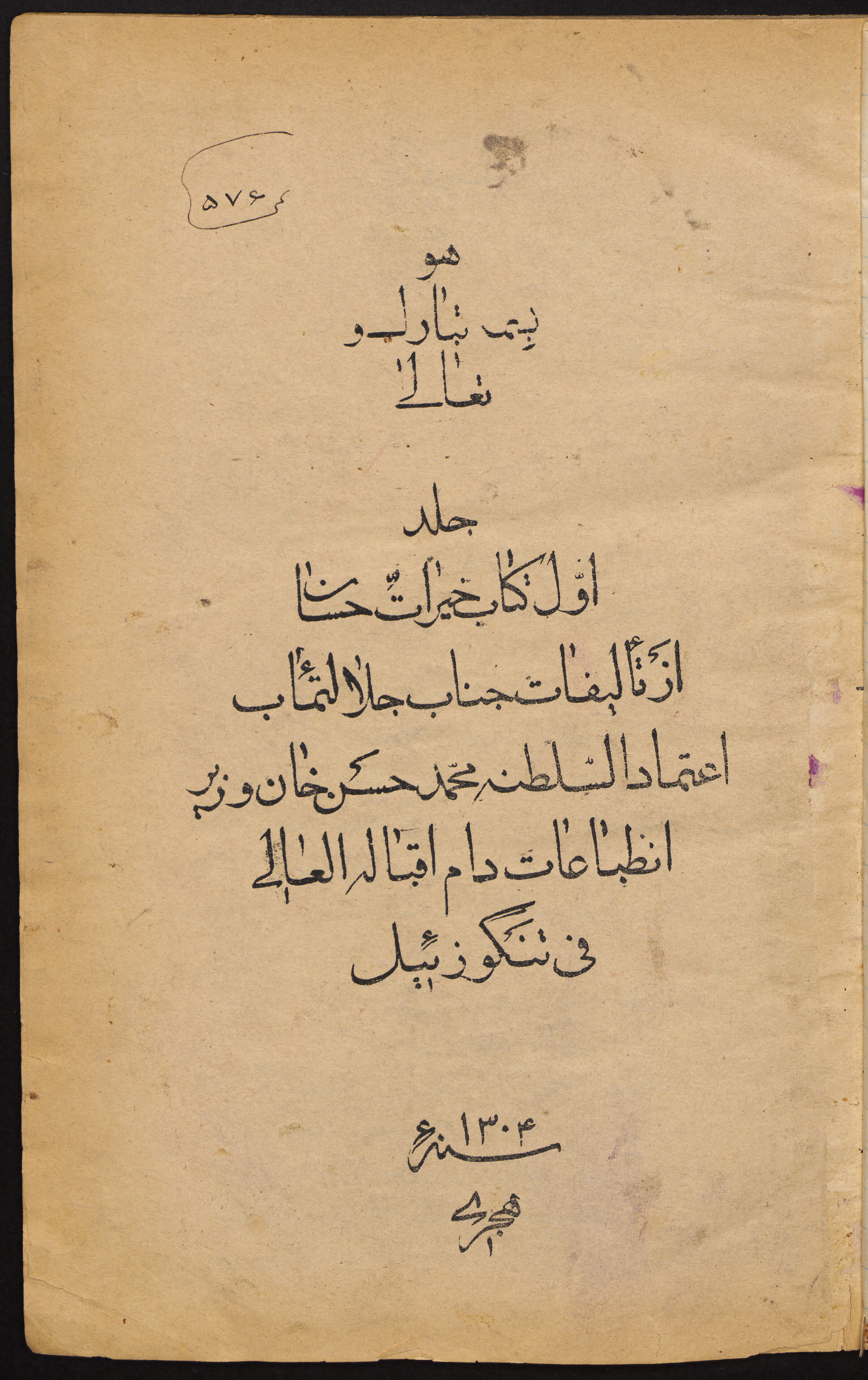|
Mohammad Hasan Khan E'temad Os-Saltaneh
Mohammad Hasan Khan E'temad os-Saltaneh (; 1843–1896) was an Iranian statesman, scholar, and author active during the reign of the Qajar shah (king) Naser al-Din Shah Qajar Naser al-Din Shah Qajar (; ; 17 July 1831 – 1 May 1896) was the fourth Shah of Qajar Iran from 5 September 1848 to 1 May 1896 when he was assassinated. During his rule there was internal pressure from the people of Iran, as well as external ... (). He was the son of Ali Khan Maragha'i, a member of the Moqaddam tribe who served as the ''farrash-bashi'' (court minister) during the early reign of Naser al-Din Shah. His mother was from the Qajar dynasty. E'temad os-Saltaneh's secret notebook, entitled ''Ruz-nama-ye khaterat-e E'temad-al-Saltana'', which spans over 17 years of his career, is considered his most significant work and one of the most important sources for the history of the late Qajar period. E'temad os-Saltaneh, like many of the European-educated politicians of that era, supported a sort ... [...More Info...] [...Related Items...] OR: [Wikipedia] [Google] [Baidu] |
Qajar Iran
The Guarded Domains of Iran, alternatively the Sublime State of Iran and commonly called Qajar Iran, Qajar Persia or the Qajar Empire, was the Iranian state under the rule of the Qajar dynasty, which was of Turkic peoples, Turkic origin,Cyrus Ghani. ''Iran and the Rise of the Reza Shah: From Qajar Collapse to Pahlavi Power'', I. B. Tauris, 2000, , p. 1William Bayne Fisher. ''Cambridge History of Iran'', Cambridge University Press, 1993, p. 344, Dr Parviz Kambin, ''A History of the Iranian Plateau: Rise and Fall of an Empire'', Universe, 2011, p.36online edition specifically from the Qajar (tribe), Qajar tribe, from 1789 to 1925. The Qajar family played a pivotal role in the Unification of Iran (1779–1796), deposing Lotf 'Ali Khan, the last Shah of the Zand dynasty, and re-asserted Iranian sovereignty over large parts of the Caucasus. In 1796, Agha Mohammad Khan Qajar seized Mashhad with ease, putting an end to the Afsharid dynasty. He was formally crowned as Shah after his Batt ... [...More Info...] [...Related Items...] OR: [Wikipedia] [Google] [Baidu] |
1896 Deaths
Events January * January 2 – The Jameson Raid comes to an end as Jameson surrenders to the Boers. * January 4 – Utah is admitted as the 45th U.S. state. * January 5 – An Austrian newspaper reports Wilhelm Röntgen's discovery, last November, of a type of electromagnetic radiation, later known as X-rays. * January 6 – Cecil Rhodes is forced to resign as Prime Minister of the Cape Colony, Cape of Good Hope for his involvement in the Jameson Raid. * January 7 – American culinary expert Fannie Farmer publishes her first cookbook. * January 12 – H. L. Smith takes the first X-ray photograph. * January 16 – Devonport High School for Boys is founded in Plymouth (England). * January 17 – Anglo-Ashanti wars#Fourth Anglo-Ashanti War (1895–1896), Fourth Anglo-Ashanti War: British British Army, redcoats enter the Ashanti people, Ashanti capital, Kumasi, and Asantehene Agyeman Prempeh I is deposed. * January 28 – Walter Arnold, of E ... [...More Info...] [...Related Items...] OR: [Wikipedia] [Google] [Baidu] |
1843 Births
Events January–March * January 3 – The '' Illustrated Treatise on the Maritime Kingdoms'' (海國圖志, ''Hǎiguó Túzhì'') compiled by Wei Yuan and others, the first significant Chinese work on the West, is published in China. * January 6 – Antarctic explorer James Clark Ross discovers Snow Hill Island. * January 20 – Honório Hermeto Carneiro Leão, Marquis of Paraná is appointed by the Emperor, Dom Pedro, as the leader of the Brazilian Council of Ministers, although the office of Prime Minister of Brazil will not be officially created until 1847. * January ** Serial publication of Charles Dickens's novel ''Martin Chuzzlewit'' begins in London; in the July chapters, he lands his hero in the United States. ** Edgar Allan Poe's short story " The Tell-Tale Heart" is published in ''The Pioneer'', a Boston magazine. ** The Quaker magazine '' The Friend'' is first published in London. * February 3 – Uruguayan Civil War: Argentina supports Oribe of Uruguay, an ... [...More Info...] [...Related Items...] OR: [Wikipedia] [Google] [Baidu] |
19th-century Iranian Politicians
The 19th century began on 1 January 1801 (represented by the Roman numerals MDCCCI), and ended on 31 December 1900 (MCM). It was the 9th century of the 2nd millennium. It was characterized by vast social upheaval. Slavery was abolished in much of Europe and the Americas. The First Industrial Revolution, though it began in the late 18th century, expanded beyond its British homeland for the first time during the 19th century, particularly remaking the economies and societies of the Low Countries, France, the Rhineland, Northern Italy, and the Northeastern United States. A few decades later, the Second Industrial Revolution led to ever more massive urbanization and much higher levels of productivity, profit, and prosperity, a pattern that continued into the 20th century. The Catholic Church, in response to the growing influence and power of modernism, secularism and materialism, formed the First Vatican Council in the late 19th century to deal with such problems and confirm ce ... [...More Info...] [...Related Items...] OR: [Wikipedia] [Google] [Baidu] |
Khayrat-é Hésan
''Khayrat-é Hésan'' (Persian language, Persian: خیرات حسان; lit. Fairest Women) is a comprehensive biographical encyclopedia of prominent women in the Islamic world, written in Persian and compiled in three volumes by Mohammad Hasan Khan E'temad os-Saltaneh, Mohammad Hasan Khan Maraghe’i, known as E'temad os-Saltaneh (died 1895).''Biographies of the Men of Iran in the 12th, 13th, and 14th Centuries AH'', Mehdi Bamdad, 1999, Zavar Publishing, . A notable writer and politician of the Qajar Iran, Qajar era, E'temad os-Saltaneh organised this work alphabetically and documented the lives of distinguished women from the early Islamic period to his own time. Due to its writing style, use of varied sources, and comprehensiveness, this work is considered one of the most significant historical records of its kind.Saeed Nafisi, ''History of Poetry and Prose in Iran and the Persian Language until the End of the 10th Century AH'', Tehran, 1965. The book Sources and motivation f ... [...More Info...] [...Related Items...] OR: [Wikipedia] [Google] [Baidu] |
Tarikh-e Montazam-e Naseri
Tārikh-e Montazam-e Naseri (Persian: تاریخ منتظم ناصری; lit. The Naseri Chronological History) is a historical book written in Persian by Mohammad Hasan Khan E'temad os-Saltaneh, who served as the translator and head of the royal printing house and translation bureau under Naser al-Din Shah Qajar. Kasravi, Ahmad (1973), ''Kasravi's Collection'', Tehran, printed by Yahya Zaka. The work was composed between 1880 and 1882 (1298 and 1300 AH) and presented to the Shah of Iran. It covers the general history of the world from the Hijrah of the Prophet Muhammad to the beginning of the Qajar era. The author organises his historical accounts geographically, covering Asia, Europe, Africa, and Americas, which made the book unique in its approach.Mohammad Hasan Khan E'temad os-Saltaneh, ''Tārikh-e Montazam-e Naseri'', Vol. 1, pp. 19-20, edited by Mohammad Esmaeil Rezvani, Tehran, 1984-1988 The name of the book reflects its ordered chronological structure (Tarikh-e Montazam; lit. ... [...More Info...] [...Related Items...] OR: [Wikipedia] [Google] [Baidu] |
Persian Language
Persian ( ), also known by its endonym and exonym, endonym Farsi (, Fārsī ), is a Western Iranian languages, Western Iranian language belonging to the Iranian languages, Iranian branch of the Indo-Iranian languages, Indo-Iranian subdivision of the Indo-European languages. Persian is a pluricentric language predominantly spoken and used officially within Iran, Afghanistan, and Tajikistan in three mutual intelligibility, mutually intelligible standard language, standard varieties, respectively Iranian Persian (officially known as ''Persian''), Dari, Dari Persian (officially known as ''Dari'' since 1964), and Tajik language, Tajiki Persian (officially known as ''Tajik'' since 1999).Siddikzoda, S. "Tajik Language: Farsi or not Farsi?" in ''Media Insight Central Asia #27'', August 2002. It is also spoken natively in the Tajik variety by a significant population within Uzbekistan, as well as within other regions with a Persianate society, Persianate history in the cultural sphere o ... [...More Info...] [...Related Items...] OR: [Wikipedia] [Google] [Baidu] |
Amir Kabir Publishers
Amir Kabir Publishers (; Entišarat-e Amir Kabir; also romanized as ''Amir-Kabir'' or ''Amar-i Kabir'') is a publishing house based in Tehran, Iran. It was founded on November 19, 1949, by Abdorrahim "Taghi" Jafari. It is named after Mirza Taghi Khan Amirkabir (better known as Amir Kabir) (1807–1852), who was chief minister during the reign of Naser al-Din Shah Qajar and is sometimes referred to as the Amirkabir Publication Institute. Company history Following the Islamic Revolution in 1979, the Iranian government seized Amir Kabir Publishers's assets. Subsequently, the organization's new owners imposed a new management structure. The publishing house is still active, but only publishes previously published material, classics, and conservative new books. Amir Kabir Publishers is the publisher of ''The Persian Encyclopedia''. The Amir Kabir Publishers edition of Sadegh Hedayat's novel (''The Blind Owl'') was one of the titles selected for the Library of Congress 2014 "A Tho ... [...More Info...] [...Related Items...] OR: [Wikipedia] [Google] [Baidu] |



